| Srl | Item |
| 1 |
ID:
101029
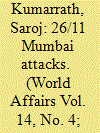

|
|
|
|
|
| Publication |
2010.
|
| Summary/Abstract |
For the Mumbai attacks of 26 November 2008, the Lashakr-e-Taiba recived training, funding and technical gadgets from the Inter-Service Intelligence (ISI) Pakistan, Middle East countries and United States (US) based companies restively. Fomenting insurgencies and supporting terrorism has been a major component of Pakistan's national strategy, especially against India. Yet t Indian security agencies are still badly trained and poorly equipped. Although, global cooperation is essential in combating international terrorism, the US has adopted selective rather than unified and comprehensive cunterterrorism measures to deal with this scourge in South Asia. It is no secret that the real rulers in Pakistan are the army and the ISI and at times they dwarf the civilian government in decision-making. If extremist forces take over Afghanistan and Pakistan, the world will become significantly less secure. However, international cooperation is not an entitlement and India must firs set its own house in order
|
|
|
|
|
|
|
|
|
|
|
|
|
|
|
|
| 2 |
ID:
106597
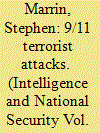

|
|
|
|
|
| Publication |
2011.
|
| Summary/Abstract |
The 9/11 terrorist attacks have been intensively examined as both tactical and strategic intelligence failures but less attention has been paid to the policy failures which preceded them. Perhaps this is due to the presumption that intelligence analysis influences decision-making as a precursor to and foundation for policy. This assumption about the influence of analysis on decision deserves a much closer examination. The 9/11 terrorist attacks provide a good case to study for greater understanding of the influence, or lack of influence, that intelligence analysis has on decision-making. Specifically, the 9/11 Commission Report identifies as a significant failure the lack of a National Intelligence Estimate on the terrorist threat between 1998 and 2001, and implies that if one had been produced it might have helped enable decision-makers to prevent the 9/11 attacks. In other words, a failure of strategic intelligence analysis lay at the foundation of the failure to prevent 9/11. But was this really the case? This article takes a closer look at the case of the missing National Intelligence Estimate by first evaluating what decision-makers knew about the threat prior to the 9/11 attacks, the policies they were implementing at the time, and the extent to which the hypothetical National Intelligence Estimate described by the 9/11 Commission would have mattered in terms of influencing their judgement and policy for the better. It concludes that the 9/11 terrorist attacks were more a failure of policy than strategic intelligence analysis.
|
|
|
|
|
|
|
|
|
|
|
|
|
|
|
|
| 3 |
ID:
111039
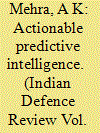

|
|
|
| 4 |
ID:
092403
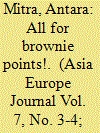

|
|
|
|
|
| Publication |
2009.
|
| Summary/Abstract |
The emergence of a global new media model aided by the technological revolution of the twenty-first century, economic globalization and political neo-liberalism, has transformed the traditional old model of media as a democratic pillar of public service into a new profit-oriented model of media as a corporate business enterprise primarily dependent on advertisement revenues. This change in the media ownership has had significant negative implications for media coverage and content. In this changed scenario of eclipse of investigative and critical journalism and triumph of infotainment journalism, this new corporate media, especially in the post-9/11 era, has nonetheless made itself particularly vulnerable to the terrorist manipulation of mass media as an advertisement agent for terror. Through the specific case study of the media coverage of Mumbai terror attacks on November 26, 2008, this study attempts to reveal how the commercial agenda of the new media ends up furthering the terrorist agenda, albeit in immediate short run, of inculcating mass hysteria, irrational mob fury directed against the state thereby eroding, however temporarily, popular sovereignty of the state.
|
|
|
|
|
|
|
|
|
|
|
|
|
|
|
|
| 5 |
ID:
106404
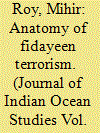

|
|
|
| 6 |
ID:
150938
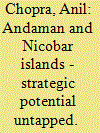

|
|
|
| 7 |
ID:
105528
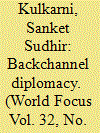

|
|
|
| 8 |
ID:
085956
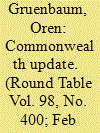

|
|
|
|
|
| Publication |
2009.
|
| Summary/Abstract |
The Awami League swept back to power in Bangladesh's first elections since a state of emergency was imposed in 2007. India accused Pakistan of aiding the Islamist terrorists who carried out the Mumbai attacks. South Africa's ruling African National Congress (ANC) split and corruption charges were revived against the ANC leader and putative next president, Jacob Zuma. Sri Lanka's army seized the Tamil Tigers' de facto capital and the country's leading journalist was assassinated. International euphoria over the election of Barack Obama as US president was tempered by the unfolding global recession; the US led the way, with 530,000 jobs lost in November.
|
|
|
|
|
|
|
|
|
|
|
|
|
|
|
|
| 9 |
ID:
092093
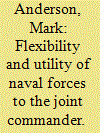

|
|
|
|
|
| Publication |
2009.
|
| Summary/Abstract |
The attacks in Mumbai last year were a wake-up call to wider world, not merely in their audacity or their target, but also in the method by which the terrorists chose to enter India.
|
|
|
|
|
|
|
|
|
|
|
|
|
|
|
|
| 10 |
ID:
118364
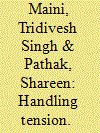

|
|
|
| 11 |
ID:
125909
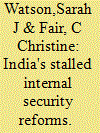

|
|
|
|
|
| Publication |
2013.
|
| Summary/Abstract |
Following the 2008 terrorist attack on Mumbai-an attack which had been amply foreshadowed by intelligence and previous, similar strikes-India's government promised unprecedented reforms to the nation's internal security architecture. Five years after Mumbai however, these reforms have almost completely failed to bear fruit. This article reviews both the reasons that the Mumbai attacks had such an impact within India's politics and also why the promised reforms were never able to take shape. It argues that the high-profile nature of the Mumbai attacks, and their effect on India's economic elite, forced the central government to respond. But India's states are so adamantly opposed to the loss of autonomy, particularly over their police forces, that substantive security reform would entail. Thus the prospects for effective reform in the foreseeable future are dim.
|
|
|
|
|
|
|
|
|
|
|
|
|
|
|
|
| 12 |
ID:
116043
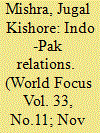

|
|
|
| 13 |
ID:
128924


|
|
|
| 14 |
ID:
105547
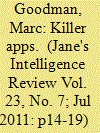

|
|
|
| 15 |
ID:
107150
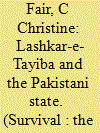

|
|
|
|
|
| Publication |
2011.
|
| Summary/Abstract |
Lashkar-e-Tayiba (LeT) is the most lethal terrorist group operating from South Asia. Founded in 1989 in Afghanistan with help from Pakistan's Inter-Services Intelligence (ISI), it began operations in India in 1990. Until November 2008, US policymakers tended to dismiss LeT as India's problem, despite the fact that the group had been attacking US troops and their international and Afghan allies in Afghanistan. On 26 November 2008, however, LeT made its debut as an international terrorist organisation when it launched a four-day siege of India's port city of Mumbai. In that attack, 166 people perished, including several Americans and Israelis. This was the first time that LeT had targeted non-Indian civilians. Recent revelations that David Coleman Headley, an American citizen of Pakistani origin, conspired with LeT (and, allegedly, a Pakistani army major deputed to the ISI) to launch the Mumbai offensive have stoked fears about American home-grown terrorism and the ability of LeT to attack the US homeland. Headley's ties to an al-Qaeda leader, Ilyas Kashmiri, have furthered speculation about LeT's ties to al-Qaeda. Rightly or wrongly, some American officials believe it is only a matter of time beforeLeT will launch an attack on US soil.
|
|
|
|
|
|
|
|
|
|
|
|
|
|
|
|
| 16 |
ID:
106522
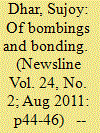

|
|
|
| 17 |
ID:
102275
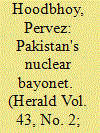

|
|
|
| 18 |
ID:
107302
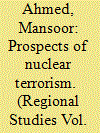

|
|
|
| 19 |
ID:
122629
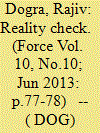

|
|
|
| 20 |
ID:
109769
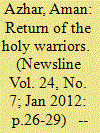

|
|
|
|
|
| Publication |
2012.
|
| Summary/Abstract |
Anti-US sentiment and anti-government chants formed the fallying cry of a cabal of religious groups, including some terrorist organisations, who joined together to form a coalition called the Difaa-e-Pakistan Council.
|
|
|
|
|
|
|
|
|
|
|
|
|
|
|
|